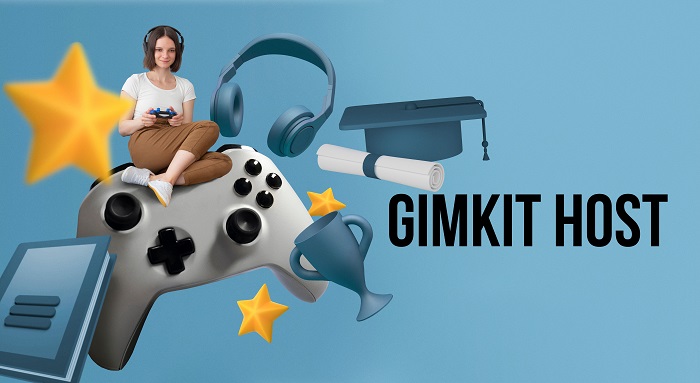In the evolving landscape of educational technology, platforms that blend learning with engagement are transforming how educators teach and students learn. Among these tools, Gimkit stands out as a dynamic, game-based learning platform designed to make education interactive and fun. At the heart of this experience is the Gimkit Host, a feature that empowers educators to create, manage, and customize live quiz games tailored to their classroom needs. This article explores the role of the Gimkit Host, its features, benefits, and practical strategies for maximizing its potential in educational settings.
What Is Gimkit
Gimkit is an online learning platform that gamifies quizzes, turning traditional assessments into competitive or collaborative games. Developed by a high school student in 2017, the platform has gained popularity for its intuitive design and adaptability. Students participate in live games by answering questions on their devices, earning in-game currency for correct answers. They can then reinvest this currency into power-ups or bonuses to gain an edge over peers. The result is a high-energy environment where learning feels like play.
Central to Gimkit’s functionality is the Host—typically a teacher, trainer, or facilitator—who designs the game, sets rules, and guides the experience. The Host’s role is critical in ensuring the game aligns with learning objectives while keeping students motivated.
Key Features of the Gimkit Host
The Gimkit Host dashboard offers a suite of tools to create immersive learning experiences. Below are its standout features:
- Customizable Game Modes
Hosts can choose from multiple game modes to suit different class dynamics. For example, Classic Mode pits students against each other in a race to earn the most virtual cash. Team Mode encourages collaboration, while Hidden Mode adds mystery by hiding scores until the end. New modes are frequently added, ensuring fresh ways to engage learners. - Question Set Creation and Importing
Hosts build “Kits” (quiz sets) using either Gimkit’s editor or by importing existing question sets from spreadsheets or other platforms. Questions can include multiple-choice, text input, or even image-based prompts. This flexibility allows educators to repurpose materials or create new content aligned with current lessons. - Real-Time Monitoring
During gameplay, Hosts view a live dashboard displaying student progress, scores, and participation. This feature helps identify students who may be struggling, allowing for on-the-spot interventions or post-game reviews. - Adjustable Settings
Hosts control game duration, cash bonuses, penalties for incorrect answers, and power-up availability. These settings can be tweaked to emphasize speed, accuracy, or strategy, depending on learning goals. - Rewards and Incentives
The Host can introduce in-game incentives, such as bonus streaks for consecutive correct answers or “insurance” to protect earnings. These elements motivate students to stay focused and think critically. - Post-Game Reports
After the game, Hosts access detailed reports highlighting class performance, frequently missed questions, and individual progress. This data informs future instruction and identifies knowledge gaps.
How to Host a Gimkit Game: A Step-by-Step Guide
Hosting a Gimkit game involves a straightforward process:
- Create an Account
Educators sign up for a free or paid Gimkit account. Paid plans unlock additional features like advanced game modes and larger question banks. - Build or Import a Kit
Navigate to the “Kits” section to create a new quiz. Enter questions manually, or import from a spreadsheet. Each question can include hints or explanations to aid learning. - Select a Game Mode
Choose a mode that aligns with lesson objectives. For review sessions, “Classic” or “Time Attack” might work best. For group projects, “Team Mode” fosters collaboration. - Configure Settings
Adjust game length, cash values, and power-ups. For younger students, reducing penalties for wrong answers can keep the experience positive. - Launch the Game
Share the game code with students, who join via their devices. Once everyone is in, the Host starts the game and monitors the live dashboard. - Facilitate and Adapt
During gameplay, the Host can pause to explain tricky concepts, extend time, or adjust difficulty based on real-time feedback. - Review Results
After the game, discuss class performance and use reports to plan follow-up activities.
Benefits of Using Gimkit Host
- Increased Engagement
The competitive, game-like format captivates students, especially those who may disengage during traditional lectures. Earning rewards and competing for leaderboard positions drives participation. - Personalized Learning
Hosts tailor games to class needs—scaling difficulty, emphasizing specific topics, or adjusting pacing. This adaptability supports differentiated instruction. - Immediate Feedback
Students see instant results after each question, reinforcing correct answers and correcting misconceptions. Hosts also gain insights into collective understanding. - Collaboration and Critical Thinking
Team-based modes teach students to strategize and communicate. Power-ups add layers of decision-making, encouraging analytical thinking. - Stress-Free Assessment
Gimkit turns assessments into low-stakes games, reducing test anxiety. Students focus on mastery rather than grades.
Tips for Effective Hosting
- Align Games with Objectives
Ensure questions directly relate to lesson goals. Use Gimkit for review, formative assessments, or vocabulary drills. - Experiment with Modes
Rotate game formats to maintain novelty. Try “Trust No One” (a detective-themed mode) or “Draw That” (for visual learners). - Encourage Reflection
After games, hold a brief discussion on what students learned or found challenging. - Leverage Student-Created Kits
Have students design their own quizzes, fostering ownership of learning. - Balance Competition and Fun
Avoid overemphasizing scores. Celebrate effort and improvement to keep the environment inclusive.
Conclusion
The Gimkit Host is more than a game manager—it’s a gateway to transforming classrooms into vibrant learning hubs. By leveraging customization, real-time data, and gamification, educators can foster deeper engagement, collaboration, and academic growth. As technology continues to shape education, tools like Gimkit empower teachers to meet students where they are, blending curriculum with creativity. Whether reviewing for a test or introducing a new topic, the Gimkit Host turns learning into an adventure where every student wants to participate.

